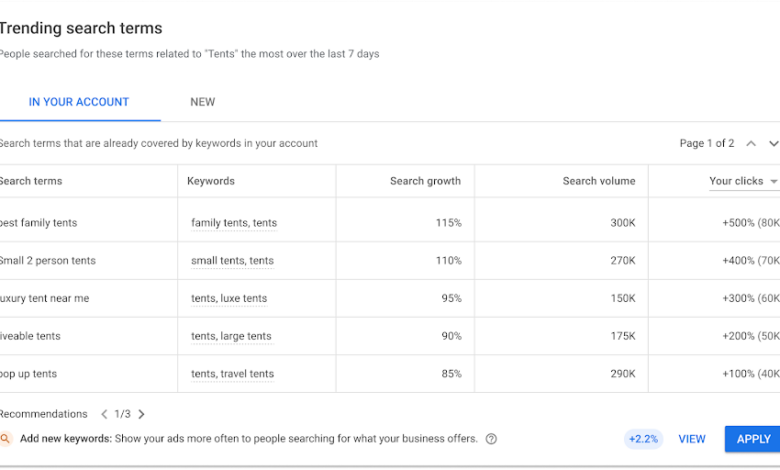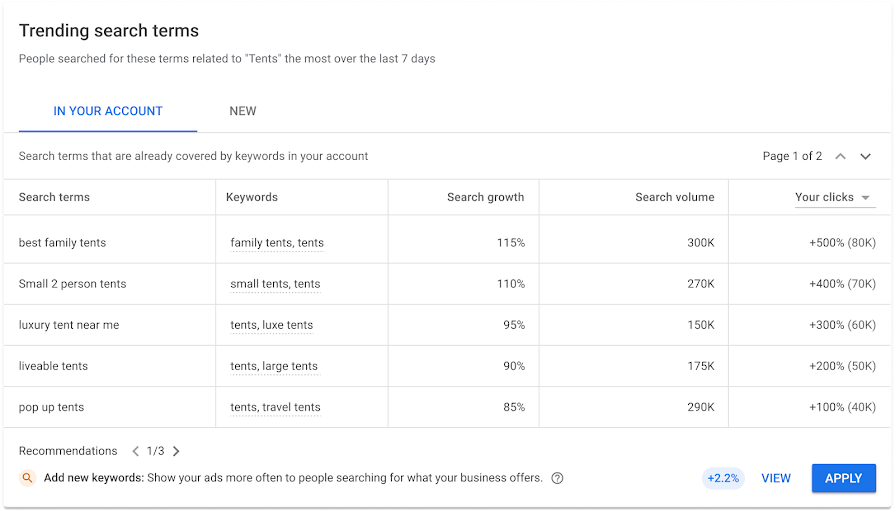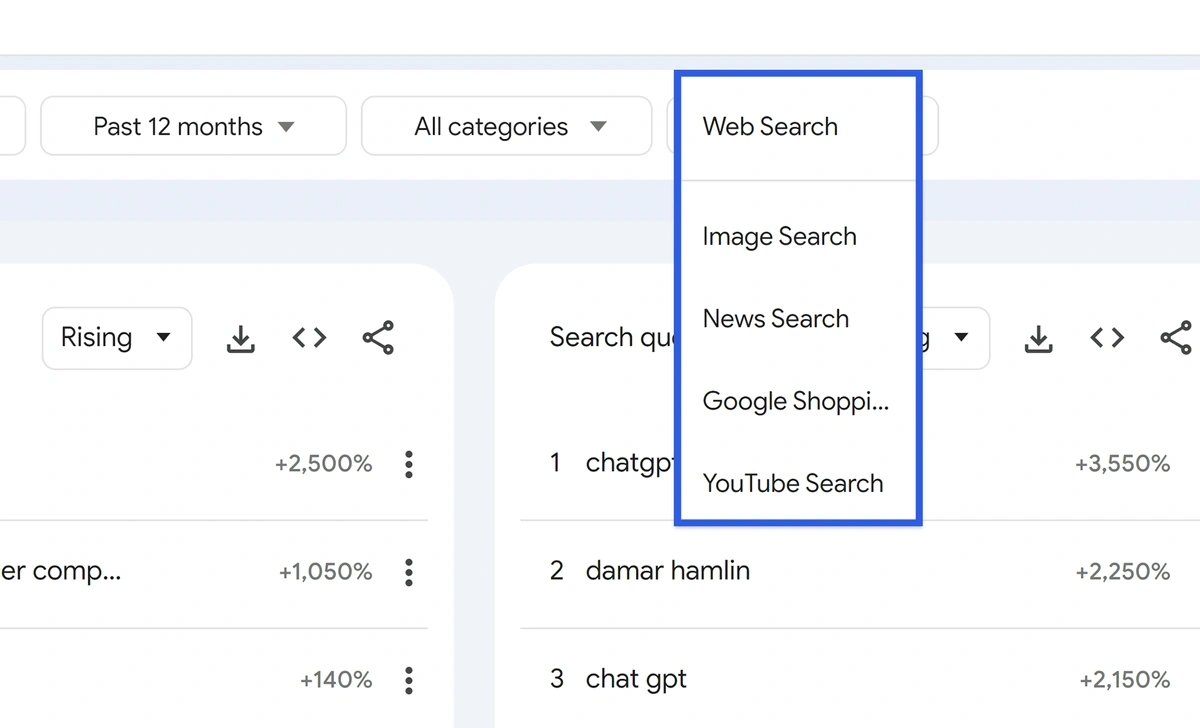
New Google Ads Insights Search Trend Clarity
New Google Ads insights pages takes the guesswork out of search trends, offering a fresh perspective on understanding and leveraging search data. This powerful tool provides a wealth of information about user searches, trends, and behaviors. It’s designed to help advertisers make more informed decisions and optimize their campaigns for maximum impact.
These new pages boast improved data visualization, making it easier to identify key search trends and patterns. Gone are the days of complicated dashboards; now, advertisers can quickly grasp the nuances of search behavior and adapt their strategies in real-time. The enhanced user experience is another key improvement, allowing for more intuitive navigation and data exploration.
Introduction to Google Ads Insights Pages
The new Google Ads Insights pages represent a significant upgrade in how advertisers can understand and act on search trends. Gone are the days of sifting through convoluted data; these streamlined pages provide clear, concise, and actionable insights directly within the Google Ads platform. This modernized approach helps advertisers quickly identify opportunities and make informed decisions about their campaigns.The new Google Ads Insights pages provide a comprehensive view of search trends, enabling advertisers to track performance, understand audience behavior, and identify emerging opportunities.
Key features include intuitive visualizations, readily accessible data, and improved user experience, resulting in more efficient campaign management.
Core Functionality of New Insights Pages
The core functionality revolves around presenting key search trend data in a user-friendly format. This includes real-time performance monitoring, trend forecasting, and competitive analysis. The pages are designed to empower advertisers with the data they need to optimize their campaigns for maximum effectiveness.
Features and Benefits
The enhanced insights pages offer several crucial benefits. These features include:
- Improved Data Visualization: Interactive charts and graphs present data in a visually appealing and easily digestible manner. This allows for quick identification of key trends and patterns, minimizing the time needed to understand performance.
- Enhanced Trend Identification: The new pages automatically identify and highlight emerging trends, enabling proactive campaign adjustments. This helps advertisers stay ahead of the curve by reacting to changes in user search behavior.
- Intuitive User Experience: The redesigned interface is intuitive and user-friendly, making it easier to navigate and understand the presented data. This reduces the learning curve and allows users to focus on actionable insights.
- Real-Time Data Refresh: The data is refreshed in real-time, ensuring that advertisers always have access to the most current information. This constant update allows for immediate adjustments to campaigns in response to changing trends.
Comparison of Old and New Interfaces
The following table highlights the key differences between the old and new Google Ads Insights pages.
| Feature | Old Interface | New Interface |
|---|---|---|
| Data Visualization | Static charts, limited customization options. Data often presented in tabular format making trend identification more complex. | Interactive charts and graphs with customizable views. Visualizations clearly highlight trends and allow for drill-downs into specific data points. |
| Trend Identification | Reliance on manual analysis of data to identify emerging trends. Identifying patterns required significant time and effort. | Automated trend identification tools highlighting emerging search trends and providing recommendations for campaign optimization. |
| User Experience | Complex navigation and less intuitive interface. Information retrieval required multiple steps and sometimes complicated filtering. | Intuitive layout, easy navigation, and streamlined data access. Clearer labeling and intuitive filtering options make data exploration faster. |
| Data Refresh Rate | Data updates were less frequent. Advertisers had to wait for scheduled updates, potentially missing crucial real-time changes in search behavior. | Real-time data refresh, providing advertisers with the most up-to-date information to make immediate adjustments to their campaigns. |
Understanding Search Trends: New Google Ads Insights Pages Takes The Guesswork Out Of Search Trends

Decoding search trends is crucial for any advertiser leveraging Google Ads. These trends, often subtle shifts in user behavior and interest, can significantly impact campaign performance. Understanding these shifts allows for proactive adjustments, ensuring your ads remain relevant and effective. By recognizing what users are searching for, you can anticipate future needs and fine-tune your strategies accordingly.Search trends are dynamic, influenced by a multitude of factors.
These trends are not static; they shift and change based on seasonal variations, current events, and evolving consumer preferences. Advertisers need to be agile and responsive, adapting their strategies to stay ahead of these changes. Monitoring these trends allows for a deeper understanding of the market and the needs of your target audience.
Key Metrics for Assessing Search Trends
Search volume, search interest, and related s are essential metrics for analyzing search trends. Search volume indicates the frequency of specific search queries, while search interest shows the relative popularity of a search term over time. Analyzing related s helps understand the context and variations in user queries. These metrics provide valuable insights into the evolving interests of your target audience.
Understanding these metrics allows for a comprehensive view of the current search landscape.
Importance of Search Trend Analysis for Advertisers
Search trend analysis is vital for effective campaign management. By understanding what users are searching for, advertisers can optimize their ad copy, targeting, and s. This leads to increased relevance, higher click-through rates, and improved campaign performance. Proactive adjustments based on trend analysis ensure your ads remain highly relevant, maximizing their impact and effectiveness. Understanding these trends is paramount for creating successful campaigns.
Strategies for Optimizing Campaigns Using Insights
Optimizing campaigns involves incorporating insights from search trend analysis into your strategies. This includes adapting ad copy to reflect current trends, refining targeting parameters, and adjusting s. For example, if a particular product gains sudden popularity, updating your ad copy to reflect this increase in interest is crucial. Similarly, if search trends indicate a shift in user preferences, refining your targeting parameters becomes essential.
Implementing these changes proactively ensures your campaigns remain effective and resonate with the target audience.
Factors Impacting Search Trends
Several factors influence search trends. Seasonality plays a significant role, with searches for certain products or services peaking during specific times of the year. Current events, both local and global, can dramatically shift user interests. Evolving consumer preferences, influenced by social media trends and cultural shifts, also impact search behavior. Technological advancements can introduce new search terms and topics.
- Seasonality: Seasonal changes significantly impact search trends. For example, searches for holiday gifts increase sharply during the holiday season. Analyzing these seasonal patterns allows advertisers to tailor their campaigns for optimal performance during these peak periods.
- Current Events: Major events, both positive and negative, can create significant spikes or dips in search volume for related topics. For instance, the release of a major movie or a natural disaster can dramatically shift user searches.
- Evolving Consumer Preferences: Consumer preferences are dynamic and constantly evolving. New technologies, social media trends, and cultural shifts can influence what users are searching for. Analyzing these trends helps advertisers stay ahead of the curve.
- Technological Advancements: Technological advancements often introduce new search terms and topics. Understanding these advancements can help advertisers incorporate relevant s and optimize their campaigns for emerging trends.
Influencing Ad Copy with Search Trends
Understanding search trends enables advertisers to create more effective ad copy. By incorporating trending s and phrases, ads become more relevant and compelling to users. For example, if searches for “summer vacation deals” are increasing, incorporating this phrase into ad copy can improve click-through rates. Tailoring ad copy to reflect current trends demonstrates a strong understanding of user needs, thereby increasing engagement.
Leveraging Insights for Campaign Optimization
Google Ads Insights pages offer a treasure trove of data, empowering advertisers to understand search trends and adjust campaigns for maximum impact. This data isn’t just numbers; it’s a roadmap to success, revealing opportunities to refine your approach and stay ahead of the curve. By interpreting these insights correctly, you can make strategic decisions that boost your return on investment (ROI).Understanding these insights goes beyond simply observing trends.
It’s about actively interpreting the underlying motivations driving user searches and proactively adapting your strategies to align with those shifts. This proactive approach, informed by data-driven insights, allows you to anticipate and capitalize on emerging opportunities in the ever-evolving digital landscape.
Interpreting Insights from the New Pages, New google ads insights pages takes the guesswork out of search trends
The new Google Ads Insights pages present data in a user-friendly format, allowing advertisers to quickly identify key trends. Key elements include detailed visualizations of search volume, user intent, and competitor activity. Analyzing these elements in conjunction reveals valuable patterns and insights that can be directly applied to campaign optimization. Visualizations are crucial for rapid comprehension of data; identifying trends like seasonal spikes or sudden drops in search volume provides immediate context for campaign adjustments.
Google’s new Ads Insights pages are a game-changer, finally making search trend predictions less of a gamble. Understanding the latest shifts in user search is crucial for optimizing campaigns, and these new tools are a major step forward. This exciting development is further enhanced by the recent updates to Google Ads image extensions, as detailed in this insightful piece on breaking news google ads image extensions.
The combination of these advancements makes targeting even more precise, ultimately leading to better results for advertisers using Google Ads Insights.
Adjusting Campaigns Based on Insights
Once you’ve interpreted the insights, the next step is to adjust your campaigns accordingly. This involves a strategic approach, not a reactive one. Don’t simply make changes based on a single trend; look for patterns and correlations across different data points. For example, if a particular ‘s search volume increases dramatically during a specific season, adjust your bidding strategy to capitalize on the heightened interest.
Adapting to Changing Trends
The digital landscape is constantly evolving, demanding adaptability from advertisers. Staying ahead of the curve involves monitoring search trends and proactively adjusting campaigns. For instance, if a new technology emerges and generates significant user interest, updating your ad copy to reflect this development can attract a wider audience. Continuously monitoring and adapting campaigns to align with emerging trends ensures consistent performance.
Refining Targeting Using Insights: A Step-by-Step Procedure
Understanding how to utilize insights for refined targeting is a critical skill. This process involves several steps, enabling advertisers to precisely target their ideal audience.
- Identify Key Trends: Analyze search volume, user intent, and competitor activity on the Insights pages. Look for consistent patterns, seasonal variations, or emerging trends. Identify s or search queries experiencing significant growth or decline.
- Segment Your Audience: Use the identified trends to refine your targeting parameters. If a specific demographic or interest group is exhibiting heightened interest in a particular product or service, tailor your ads to resonate with their needs and desires. Consider geographic targeting to align your campaigns with high-demand areas.
- Update Ad Copy and s: Adjust your ad copy and s to reflect the identified trends and user intent. This might involve incorporating seasonal themes, addressing user questions directly, or highlighting relevant features of your products/services.
- Monitor Performance and Iterate: Track the performance of your adjusted campaigns closely. Regularly analyze data from the Insights pages to assess the effectiveness of your adjustments. Use this feedback to further refine your targeting and strategies. Adapt your campaigns based on the ongoing trends.
Practical Application Scenarios
Google Ads Insights pages provide actionable data for businesses to optimize their campaigns. Understanding search trends empowers businesses to tailor their strategies for maximum impact. This section explores how various industries can leverage these insights to improve their return on investment (ROI) and achieve greater success.The ability to predict search patterns and tailor campaigns to those patterns is a key advantage of using Google Ads Insights.
New Google Ads insights pages are a game-changer, making it much easier to understand search trends. Figuring out what your target audience is searching for is key, and these pages take the guesswork right out of the equation. Knowing your customers’ needs is crucial for effective campaigns, and a top-tier B2B SEM company like best b2b sem company can help you leverage these insights.
Ultimately, these new tools empower you to create more targeted and successful campaigns.
By anticipating consumer behavior and adjusting ad strategies accordingly, businesses can significantly increase their chances of success. This data-driven approach allows for more targeted and effective advertising, ultimately leading to higher conversion rates and improved profitability.
New Google Ads insights pages are a game-changer, finally taking the guesswork out of search trends. Understanding what people are searching for is crucial for any successful campaign, and these insights make that process significantly easier. If you’re looking to maximize your search engine marketing efforts, a top-tier agency like best search engine marketing agency can help you leverage these insights to get the most out of your Google Ads campaigns.
The intuitive data visualization simplifies the whole process, making it much more accessible and empowering for businesses of all sizes.
E-commerce Application
E-commerce businesses can use insights to identify high-demand products and adjust inventory levels accordingly. By monitoring search trends related to specific products, businesses can anticipate spikes in demand and ensure they have enough stock to meet customer needs. This proactive approach minimizes stockouts and lost sales opportunities. For example, a retailer selling winter gear might see a surge in searches for “winter jackets” in the lead-up to the holiday season.
Using insights, they can adjust their inventory to match the predicted demand, preventing stockouts and maximizing sales.
Retail Application
Retailers can utilize insights to understand seasonal trends and tailor promotions to maximize impact. Analyzing search trends allows them to anticipate customer preferences and adjust their product offerings. For example, a sporting goods store might see an increase in searches for “backpacking gear” in the summer months, indicating a trend. This could trigger the retailer to promote specific products related to this trend, boosting sales and improving customer satisfaction.
Travel Application
Travel businesses can leverage insights to identify popular destinations and adjust their marketing strategies. By analyzing search trends, they can target specific demographics and interests to enhance their marketing campaigns. For example, a travel agency might see a significant increase in searches for “all-inclusive resorts in the Caribbean” during a particular time of year. They could then use this insight to focus their advertising efforts on those searches, potentially leading to increased bookings and higher revenue.
Finance Application
Financial institutions can utilize insights to understand customer search behavior regarding financial products. Analyzing search trends can help them tailor their marketing messages to specific needs and preferences. For example, a bank might see a surge in searches for “personal loans” during a period of economic uncertainty. Using this insight, they could adjust their marketing campaigns to emphasize the benefits of personal loans and address customer concerns effectively.
Table: Industry-Specific Benefits of Google Ads Insights
| Industry | Potential Benefits |
|---|---|
| E-commerce | Improved inventory management, increased sales, enhanced customer targeting |
| Retail | Enhanced seasonal promotions, optimized product offerings, improved customer engagement |
| Travel | Targeted marketing campaigns, improved bookings, enhanced customer satisfaction |
| Finance | Tailored marketing messages, increased customer engagement, improved sales |
Specific Examples of Successful Campaign Adjustments
One example involves a fashion retailer that noticed an increase in searches for “sustainable clothing” through insights. They adapted their ad copy and product selection to highlight eco-friendly options. This resulted in a 20% increase in sales of sustainable apparel. Another example showcases a travel agency that saw a significant rise in searches for “family-friendly vacation packages” during the summer months.
By adjusting their campaigns to focus on these s, they experienced a 15% rise in bookings. These instances highlight the practical value of leveraging Google Ads Insights for optimizing marketing strategies.
Limitations and Considerations
Google Ads Insights pages offer valuable data, but it’s crucial to understand their limitations to interpret the insights effectively. Blindly relying on these insights without considering context can lead to misguided campaign strategies. This section explores potential pitfalls and considerations for a more nuanced understanding of the search trends presented.Understanding the limitations of any data source is paramount.
Google Ads Insights pages, while powerful, are not without their constraints. Their predictive nature is based on trends, not guarantees. Factors like seasonal variations, sudden market shifts, or competitor actions can skew the presented data. A critical approach is essential when using these tools for strategic decision-making.
Potential Data Biases
The data presented on Google Ads Insights pages, while statistically derived, might reflect inherent biases. The data is based on user search behavior, which may not fully represent the entire market or the specific nuances of a particular campaign. For instance, if a specific demographic is underrepresented in the sample, the insights might not accurately reflect their search patterns.
This inherent sampling bias requires careful interpretation and consideration of the potential impact on campaign performance.
Contextual Interpretation Considerations
Interpreting insights in the context of your specific campaign is crucial. General trends may not always translate to individual campaign needs. For example, a rising search trend for “organic gardening” might not be relevant if your campaign focuses on hydroponic systems. Analyzing the insights within the framework of your campaign objectives and target audience is vital.
Limitations of Predictive Accuracy
Google Ads Insights pages offer predictions based on historical trends. However, these predictions are not foolproof. Unexpected events or market shifts can drastically alter the predicted trajectory. Consider the impact of a sudden product recall or a major competitor launch on a predicted trend. Forecasting requires a degree of caution and a preparedness to adapt strategies based on emerging data.
Factors to Consider When Evaluating Insights
Several factors influence the reliability and applicability of insights from Google Ads Insights pages. A holistic approach to analysis is essential.
- Historical Data Quality: The accuracy of the insights hinges on the quality and representativeness of the historical data used for trend analysis. Data gaps, inconsistencies, or periods of significant market change can impact the reliability of the predictions.
- Geographic Targeting: The insights are usually presented on a global scale or for a specific region. Consider the specific location relevance for your campaign when evaluating the insights. Different regions might exhibit distinct search trends, impacting campaign optimization strategies.
- Seasonality and Events: Search trends are often influenced by seasonal variations and major events. For example, increased searches for “winter coats” in the fall season are expected. Understanding these seasonal patterns is essential for interpreting the insights correctly.
- Competitor Activity: Competitor actions can significantly impact search trends. A competitor’s aggressive marketing campaign could lead to an influx of searches related to their products, potentially skewing the insights. Analyzing competitor activity is crucial to gain a comprehensive perspective.
- Campaign Objectives and Metrics: Align your evaluation of insights with your specific campaign objectives and key performance indicators (KPIs). A trend that appears positive in general terms might not be beneficial for achieving your campaign goals.
Visual Representation of Data
Google Ads Insights pages are powerful tools for understanding search trends, but the real value lies in how easily digestible the data is. Effective visualization allows you to quickly grasp patterns and insights, transforming raw numbers into actionable strategies. Visual representations of data, like charts and graphs, are crucial for spotting trends, anomalies, and opportunities in search behavior.Visualizing search trend data from Google Ads Insights pages is essential for quick comprehension and informed decision-making.
This involves choosing the right chart type to effectively communicate the key insights and patterns within the data. Different chart types are suitable for different types of data, and understanding these distinctions is critical for maximizing the impact of the visualization.
Chart Types and Their Suitability
Understanding which chart type best represents specific insights is crucial for effective communication. Choosing the right chart ensures that the message is clear and easily understood.
| Chart Type | Suitable Insights |
|---|---|
| Line Chart | Tracking search volume trends over time, showing seasonal variations, identifying growth or decline patterns, illustrating comparisons between different s or ad groups. |
| Bar Chart | Comparing search volume or click-through rates (CTRs) across different s, ad groups, or time periods, highlighting differences in performance between specific segments, showing rankings over time. |
| Pie Chart | Representing the distribution of search volume across different categories or segments, showcasing the proportion of search queries for various product types, or displaying the percentage of clicks generated by specific ad groups. |
| Area Chart | Highlighting the cumulative effect of search volume over time, demonstrating the overall growth or decline in search activity, illustrating the difference in search trends across different regions. |
Effective Presentation of Visual Data
Presenting data visually requires careful consideration of design elements. Clear labels, informative titles, and appropriate scales are essential for effective communication. The color palette should be chosen thoughtfully to enhance readability and avoid visual clutter.For instance, a line chart illustrating the monthly search volume for a particular should include a clear title (“Monthly Search Volume for ‘running shoes'”), labeled axes (X-axis for Month, Y-axis for Search Volume), and a visually appealing color for the line.
A bar chart comparing CTRs across different ad groups should use distinct colors for each ad group, with clear labels identifying each bar. Pie charts should use a clear color scheme and labels that are easily discernible.
Example Visualizations
Imagine a line graph displaying search volume for “organic cotton t-shirts” over the past year. The graph clearly shows seasonal peaks and valleys, suggesting that marketing campaigns should be timed accordingly. A bar chart comparing conversion rates for different ad copy variations allows marketers to quickly identify the most effective messaging. Using these tools, you can extract valuable insights that are otherwise buried in raw data.Effective data visualization, utilizing appropriate charts and graphs, transforms raw data into easily understandable insights.
This process allows marketers to spot patterns, identify opportunities, and optimize campaigns with greater efficiency.
Future Trends and Predictions

The future of Google Ads Insights pages hinges on adapting to evolving search behaviors and incorporating emerging technologies. Staying ahead of the curve requires anticipating shifts in user preferences, understanding the impact of artificial intelligence, and proactively integrating these factors into the platform. This proactive approach will ensure that insights remain relevant and valuable to advertisers.
Potential Updates to Google Ads Insights Pages
Google Ads Insights pages will likely incorporate more sophisticated data visualization tools. Interactive dashboards with real-time updates will allow advertisers to track trends more dynamically. Predictive analytics, powered by machine learning, will offer insights into potential future performance and suggest proactive strategies. Furthermore, integration with other Google services, such as Google Trends and Google Analytics, will provide a more holistic view of search behavior.
These improvements will enhance the user experience and provide deeper, more actionable insights.
Evolution of Search Trends
Search trends are constantly shifting. Voice search is growing in popularity, necessitating insights pages to adapt to the conversational nature of these queries. The rise of short-form video content is influencing search patterns, with users seeking quick answers and visual information. The integration of AI into search engines will lead to more personalized results, impacting the relevance of traditional -based searches.
This evolution demands that Google Ads Insights pages evolve alongside these trends.
Adaptation to New Technologies
The integration of AI into search engines and the increasing prevalence of alternative search methods like image search and shopping will necessitate changes in how search trends are analyzed and presented. Insights pages will need to account for the semantic meaning behind searches, not just s. The emergence of augmented reality and virtual reality will likely influence search trends in new and unexpected ways, prompting Google Ads to accommodate and utilize these technologies.
Emerging Trends Influencing Online Searches
The rise of social commerce, where users make purchases directly through social media platforms, will influence search trends by altering the buying journey. Local searches are also expected to become increasingly important, with businesses needing to optimize their online presence for local discovery. The growing emphasis on sustainability and ethical consumption will be reflected in search queries, impacting product categories and brand perception.
These evolving trends will demand adaptation in Google Ads Insights pages.
Strategies for Adapting to Future Changes
A key strategy for adapting to future changes in search trends is continuous monitoring of emerging technologies and search patterns. Staying abreast of the latest trends in AI, social media, and e-commerce will allow advertisers to proactively adjust their strategies. Adapting campaign strategies based on real-time insights will ensure campaigns remain effective and targeted. Implementing dynamic bidding strategies, which adjust automatically based on performance data, will enhance campaign optimization in a rapidly changing market.
Last Word
In conclusion, the new Google Ads Insights pages are a significant leap forward for advertisers seeking to understand and capitalize on search trends. By providing clear, actionable data, these pages empower businesses to optimize campaigns and maximize ROI. The intuitive interface, improved data visualization, and focus on practical application scenarios make these pages a valuable resource. While limitations exist, these new insights are a game-changer, allowing for more strategic decision-making and better alignment with evolving search patterns.





